Wakayama Prefecture is home to numerous renowned spots where you can enjoy the breathtaking beauty of the changing seasons, especially the vibrant autumn leaves. As autumn approaches, you might find yourself wondering where to go for the best foliage viewing.
In this article, we’ll introduce you to 10 of the best autumn leaves spots in Wakayama Prefecture. We’ll also provide details on the highlights of each location and how to get there.
Mount Koya【Koya Town】
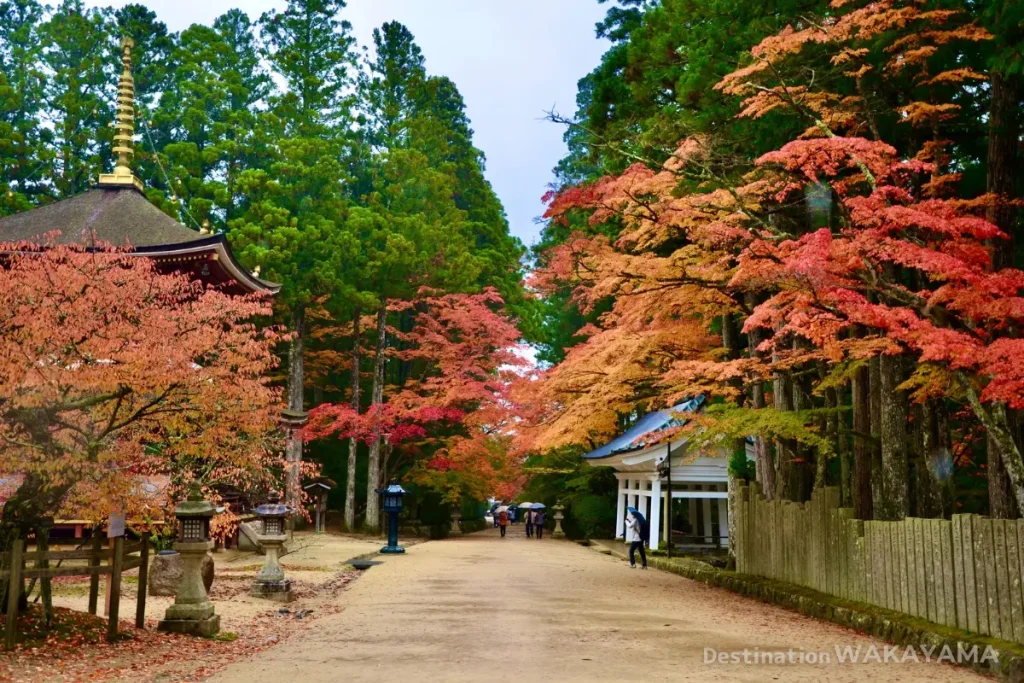
Mount Koya, established by the Buddhist monk Kobo Daishi (Kukai) in the early Heian-period, is a sacred site of Shingon Buddhism. The area spreads across a mountain basin at an altitude of about 800 meters, surrounded by peaks reaching over 1,000 meters. With 117 temples, including the famous Kongobuji Temple, Mount Koya is a major spiritual destination. Recognized as a UNESCO World Heritage Site in 2004, it is also a popular tourist spot.
While the scenery is beautiful year-round, autumn is particularly special as the mountain becomes a canvas of vibrant autumn colors.
Key Spot of Mount Koya
- Kongobuji Temple:
The main temple on Mount Koya, surrounded by colorful autumn leaves, especially around the main gate and the temple’s garden. The contrast between the historical buildings and the bright foliage is stunning. - Danjo Garan:
This area features significant historical structures like the Golden Hall and the Great Pagoda. The autumn leaves add a majestic atmosphere to this sacred site. - Jabara-michi Path:
This path, leading from Kongobuji to Danjo Garan, is one of the most popular spots for autumn foliage, with trees on both sides forming a beautiful tunnel of leaves. - Okunoin:
This is one of the most important spiritual sites on Mount Koya, where the mausoleum of Kobo Daishi is located.
During the autumn season, the area is illuminated at night, creating a magical atmosphere with the combination of lit-up foliage and historical structures.
- Best Viewing Time
-
Late October to November
- Types of Trees
-
Maple, ginkgo, oak, chestnut, etc.
- Access
-
- By Train
-
By Train: Take the Nankai Koya Line from Namba or Shin-Imamiya Station to Gokurakubashi Station, then take the Koyasan Cable Car to Koyasan Station, and continue by Koyasan Rinkan Bus.

- By Car
-
About 40 minutes from Katsuragi Nishi IC or Kihoku Katsuragi IC.
Wakayama Castle – Nishinomaru Garden (Momijidani Teien) 【Wakayama City】
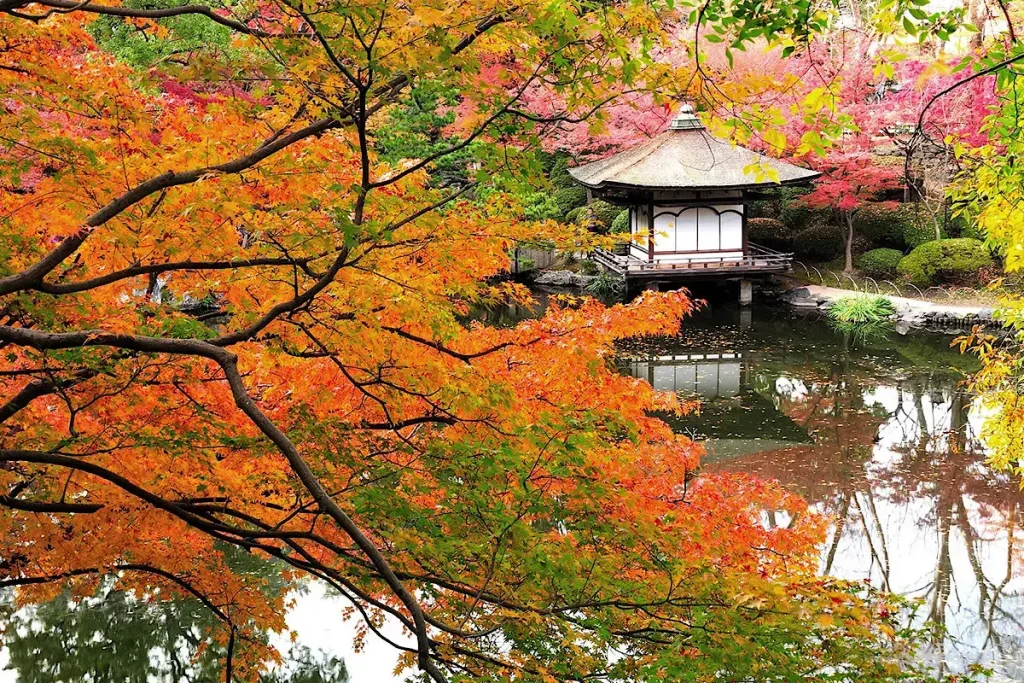
Nishinomaru Garden, commonly known as Momijidani Teien, is a famous spot for autumn foliage within Wakayama City. Built by Tokugawa Yorinobu, the first lord of the Kishu Tokugawa family, this early Edo-period garden features a strolling-style layout with a large pond representing an inner moat.
The best time to visit is from late November to early December, when the garden’s maples and other trees are at their peak. The view of the fishing pavilion “Engyokaku,” floating in the pond, framed by autumn leaves, is particularly picturesque. The garden also has various charming bridges and a waterfall, adding to its serene atmosphere.
Nishinomaru Garden is beautiful throughout the year but especially so in autumn, when it was designated as a National Place of Scenic Beauty in 1985.
- Best Viewing Time
-
Late November to early December
- Types of Trees
-
Chinese sweet gum, Maple
- Access
-
By bus from JR Wakayama Station or Nankai Wakayama City Station to “City Hall Mae,” then a short walk.
If you would like to learn more about Mount Koya, please see the article below.
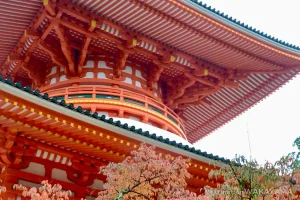
Negoroji Temple【Iwade city】
Negoroji Temple, located in Iwade City, is the head temple of the Shingi Shingon sect. Established in 1130 by Kakuban (Kogyo Daishi), the temple houses three main deities: Dainichi Nyorai, Kongosatta, and Sonsho Butcho. The temple is rich in historical heritage, including the National Treasure Great Pagoda, as well as cultural assets such as Noh masks and statues of Kobo Daishi, all designated as important cultural properties.
The temple grounds are divided into several areas, including the Great Pagoda area and the Koyoden area (both require an entrance fee), as well as the Daimon and Fudodo areas (free of charge). The entrance fee for adults is 500 yen.
The best time to view the autumn leaves here is from late November to early December. Although there is no lighting event, the natural beauty of the autumn leaves is more than enough to make your visit worthwhile.
Key Spot of Negoroji Temple
- Momiji Valley:
A walking path along Otani River within the temple grounds, where you can enjoy the colorful maples and other autumn foliage. - Great Pagoda:
The wooden Great Pagoda, built in 1547, provides a beautiful contrast with the surrounding autumn colors. This building is designated as a national treasure.
- Best Viewing Time
-
Late November to early December
- Types of Trees
-
Maple
- Access
-
- By Bus
-
- From JR Izumi-Sunagawa Station, take a Wakayama Bus to JR Iwade Station, then transfer to a bus for about 16 minutes to “Negoroji” bus stop.
- From JR Kii Station, take the Wakayama Bus bound for “Konagawa Station” or “Kindai University”, get off at the “Negoro” stop and walk for about 20 minutes
- By Car
-
About 15 minutes from Hanwa Expressway Sennan IC or 3 minutes from Keinawa Expressway Iwade-Negoro IC.
Niutsuhime Shrine 【Katsuragi Town】
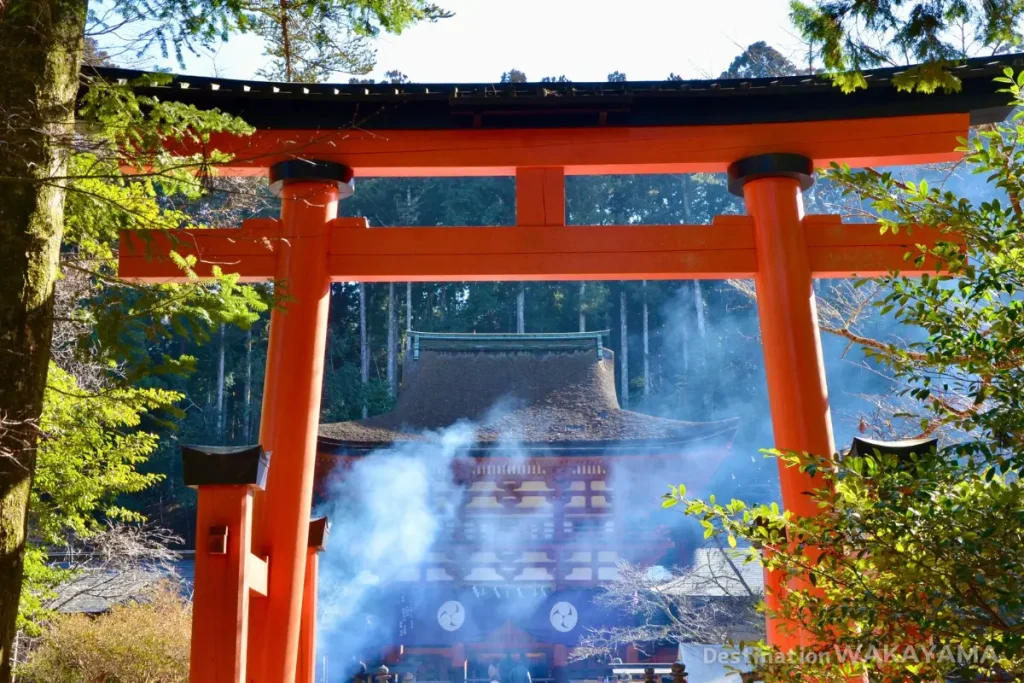
Niutsuhime Shrine has deep ties with Mount Koya, as it is said that when Kobo Daishi established Kongobuji Temple, he dedicated the surrounding lands to this shrine. For centuries, it has been a traditional stop for pilgrims heading to Mount Koya.
The shrine is located in a basin at an altitude of 450 meters, meaning the autumn leaves peak slightly earlier here than in lower areas. The most iconic feature is the vermilion Taiko Bridge, which blends beautifully with the autumn foliage and is perfect for photos.
The shrine’s main hall and gate, both designated as Important Cultural Properties, also offer a stunning contrast with the surrounding autumn colors. The Amano area where the shrine is located is in the mountains, but there are also luxury inns and dining options nearby.
- Best Viewing Time
-
Mid to late November
- Types of Trees
-
Maple
- Access
-
- By Public Transportation
-
From JR Wakayama Line “Kasada Station,” take a Katsuragi Town Community Bus to “Niutsuhime Shrine.”
- By Car
-
About 20 minutes from Katsuragi Nishi IC or Kihoku Katsuragi IC.
Koya-Ryujin Skyline 【Koya Town to Tanabe City】
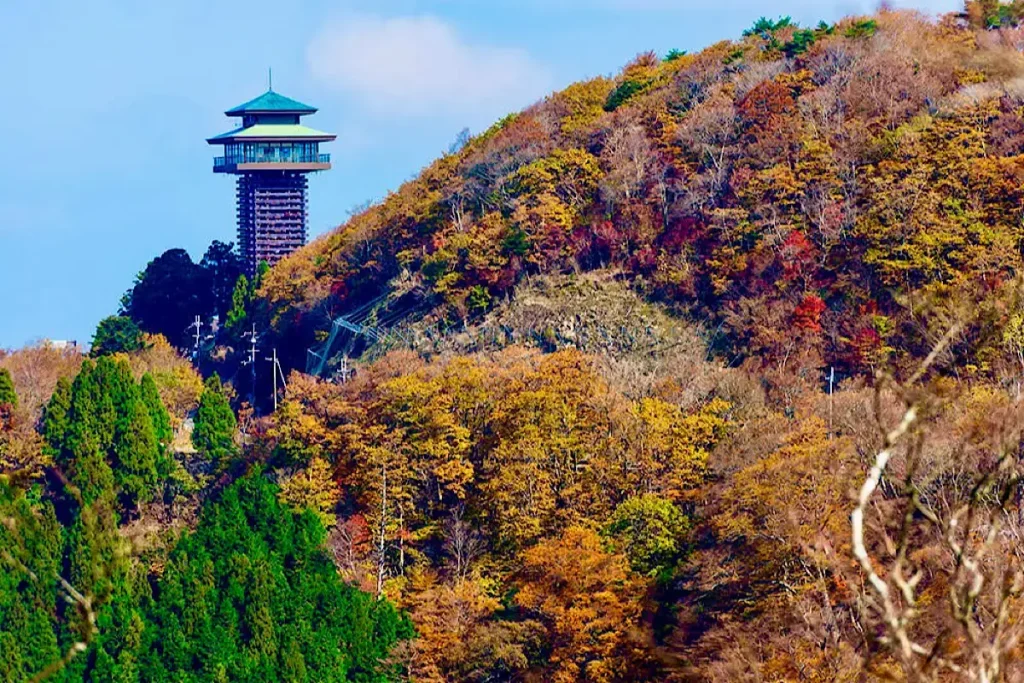
Koya-Ryujin Skyline is one of Wakayama Prefecture’s premier scenic drives. This mountain road stretches for about 42.7 kilometers from Koya Town to Ryujin Village in Tanabe City, winding through elevations ranging from 800 to 1300 meters. Originally a toll road, it has been free to use since 2003.
In autumn, the trees along the road turn brilliant colors, offering a beautiful drive. The best time to visit is from late October to early November. The foliage around Mount Gomadan is particularly stunning, with misty mornings and sunsets creating a magical atmosphere.
The roadside rest area “Gomasan Sky Tower” is located at the midpoint of the Skyline and offers panoramic views of the mountains of Wakayama and Nara. After enjoying the foliage, you can relax at Ryujin Onsen, a historic hot spring known for its healing properties. The Skyline also connects with historic sites like Mount Koya and the Kumano Kodo pilgrimage route, making it a great addition to your autumn foliage trip.
- Best Viewing Time
-
Late October to early November
- Types of Trees
-
Beech, oak, maple, Japanese walnut, azalea, etc.
- Access
-
- About 60 minutes from Keinawa Expressway “Hashimoto Higashi IC.”
- Traffic Regulations
-
Winter Restrictions (mid-December to late March):
- Daytime (7:00 AM – 5:00 PM): Winter tires required and chains recommended.
- Nighttime (5:00 PM – 7:00 AM): Road closed.
- Motorcycles: Prohibited at all times.
Kizetsu Gorge 【Tanabe City】
Kizetsu Gorge is a natural gorge located upstream of the Hidaka River in Tanabe City. The gorge features various oddly shaped rocks and large stones, offering a beautiful natural landscape throughout the year.
The best time to visit is from early to mid-November, when the trees along the riverbank turn vivid shades of red and orange, reflecting off the crystal-clear water. Several hiking trails are available in the area, allowing visitors to immerse themselves in the autumn scenery.
The area around Fudo Falls is especially rich in autumn foliage, with the sound of the waterfall providing a soothing backdrop to the vibrant colors.
A notable feature of the gorge is the “Magaibutsu,” a large stone Buddha carved into a rock face. This impressive statue, set against the backdrop of autumn leaves, leaves a lasting impression on visitors.
- Best Viewing Time
-
Early to mid-November
- Types of Trees
-
Maple, ginkgo
- Access
-
- By Bus
-
From JR Kii-Tanabe Station, take the Ryujin Bus for about 20 minutes and get off at “Kizetsu Gorge.”
- By Car
-
About 15 minutes from Nanki-Tanabe IC.
Hosenji Temple (Fukusada’s Great Ginkgo) 【Nakahechi Town, Tanabe City】
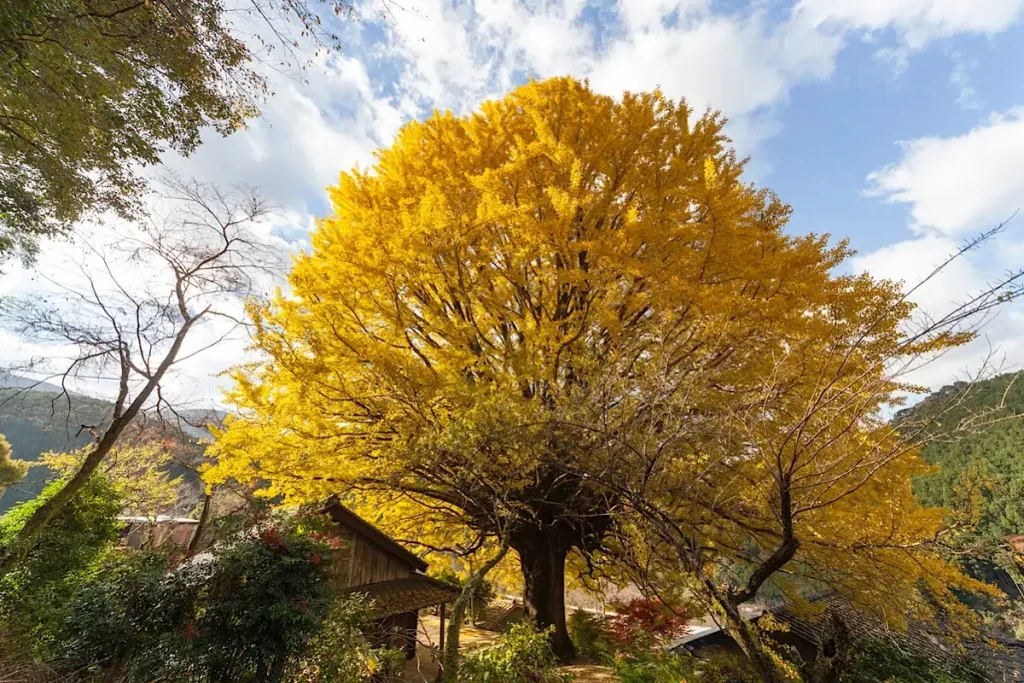
Hosenji Temple, located in Nakahechi Town, Tanabe City, is a historic temple famous for the large ginkgo tree in its grounds. This tree is estimated to be around 400 years old, standing 22 meters tall with a trunk circumference of 5.3 meters. In autumn, the ginkgo leaves turn a brilliant gold, creating a stunning sight.
The best time to visit is from mid to late November, when the entire temple grounds are bathed in golden hues. The fallen ginkgo leaves create a golden carpet, captivating all who visit. There is also nighttime illumination, adding to the magical atmosphere.
In addition to the ginkgo, the temple grounds are home to maple and other trees, making it a perfect spot to enjoy a variety of autumn colors. The temple itself is serene, offering a peaceful setting to appreciate the beauty of the season. Early mornings and evenings are particularly quiet, providing a moment of calm reflection.
- Best Viewing Time
-
Mid to late November
- Types of Trees
-
Ginkgo, maple
- Access
-
- By Bus
-
From JR Kii-Tanabe Station, take the Ryujin Bus or Meiko Bus to “Fukusada,” then walk a short distance.
- By Car
-
About 35 minutes from Kisei Expressway “Kamito IC.”
Sukumadani Kannon Temple 【Kamitonda Town】
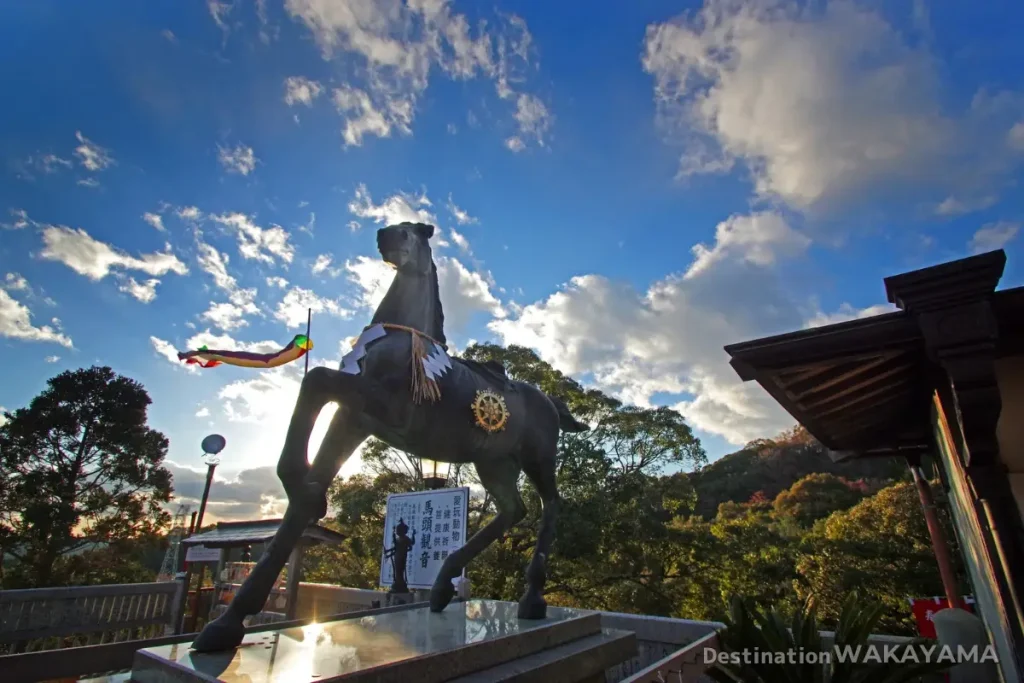
Sukumadani Kannon Temple, located in Kamitonda Town, is a quiet temple known as the oldest site for prayers for good fortune and protection in the Kinan area. The best time to visit is from late November to early December, when the temple grounds are enveloped in vibrant reds and yellows. The approach to the main hall is lined with around 500 maple trees, creating a spectacular display.
The view from the Kannon Hall, overlooking mountains covered in autumn foliage, is particularly moving. The temple grounds feature peaceful walking paths, allowing visitors to take in the beauty of the autumn leaves at their own pace. Early morning is the best time to visit, when the air is crisp and the autumn leaves can be enjoyed in solitude.
While the temple is somewhat remote, a large parking lot is available, making it easily accessible by car.
- Best Viewing Time
-
Late November to early December
- Types of Trees
-
Maple
- Access
-
- By Public Transportation
-
From JR Kisei Main Line “Asso Station,” take a taxi for about 5 minutes.
- By Car
-
About 10 minutes from Kisei Expressway “Kamitonda IC.”
Kozagawa Gorge (Kozagawa Monolith) 【Kozagawa Town】
Kozagawa Gorge, located in Kozagawa Town, is a stunning natural gorge, famous for the “Ichimaiiwa” (Monolith), a massive rock that stands about 100 meters tall and 500 meters wide. The sheer size of this rock leaves visitors in awe.
The best time to visit is in mid-November, when the autumn colors reach their peak. The gorge offers the unique experience of enjoying the autumn foliage from a canoe or boat, with the vibrant colors reflected on the water’s surface creating a breathtaking view.
Several hiking trails are also available along the gorge, allowing visitors to enjoy the scenery on foot. The surrounding area is dotted with restaurants and souvenir shops, where you can enjoy local specialties and pick up some keepsakes.
- Best Viewing Time
-
Mid to late November
- Types of Trees
-
Maple
- Access
-
- About 20 minutes from JR Kisei Line “Koza Station.”
- From Kisei Expressway “Susami Minami IC,” take Route 42 through Kushimoto Town to Kozagawa Town.
Kumano-Nachi Taisha Shrine 【Nachikatsuura Town】
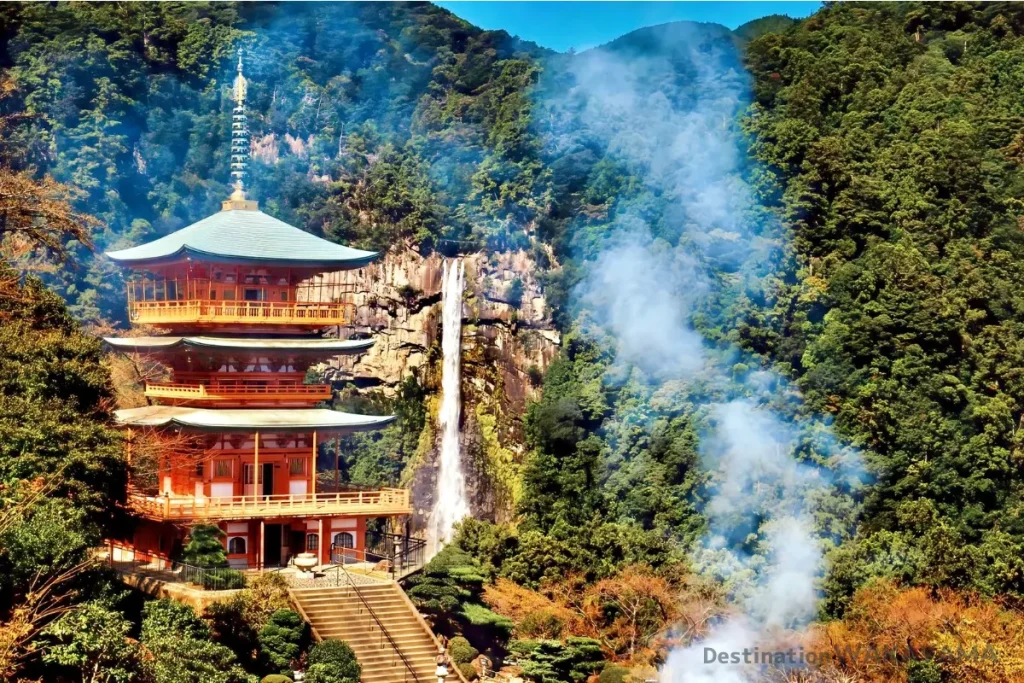
Kumano Nachi Taisha Shrine is a significant point along the Kumano Kodo pilgrimage route and is renowned for its autumn foliage as well as the famous Nachi Falls. The best time to visit is from early to late November, when the shrine and waterfall are surrounded by stunning autumn colors.
The shrine, with its solemn atmosphere, is part of a World Heritage Site along with Kumano Hongu Taisha, Kumano Hayatama Taisha, and the Kumano Kodo pilgrimage route.
On November 14th each year, Kumano Nachi Taisha holds the “Autumn Leaf Festival,” where shrine maidens dressed in Heian-period costumes perform elegant dances to the sound of flutes and drums, offering a ceremonial leaf tribute to the gods.
Walking along the Kumano Kodo while enjoying the autumn leaves is a unique experience. The path is lined with historical sites and charming signposts, offering both a cultural and natural experience. The combination of Nachi Falls and Kumano Nachi Taisha’s autumn foliage provides a rare opportunity to experience the sacred beauty of nature in this historic setting.
- Best Viewing Time
-
Early to late November
- Types of Trees
-
Maple, ginkgo
- Access
-
By Bus: From JR Kisei Line “Kii-Katsuura Station,” take the Kumano Gobo Nankai Bus to “Nachi-san,” about 30 minutes.
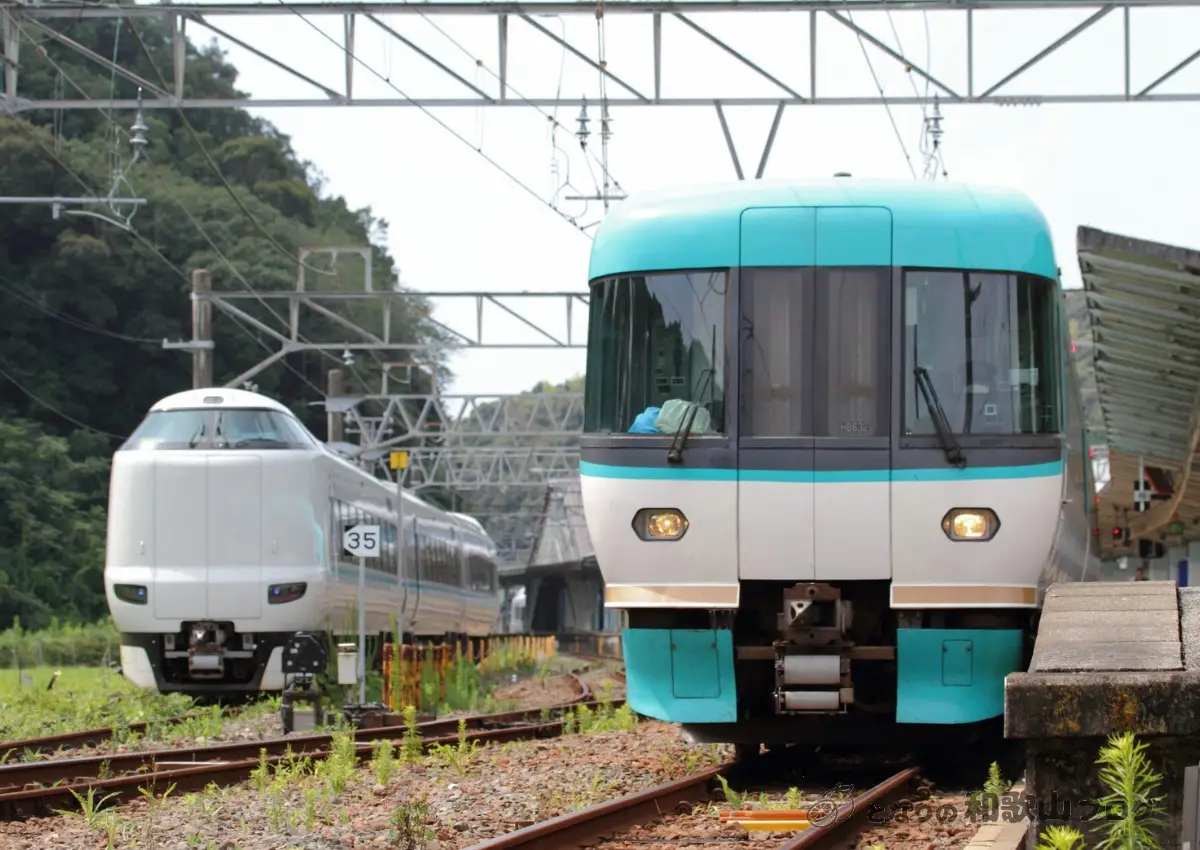
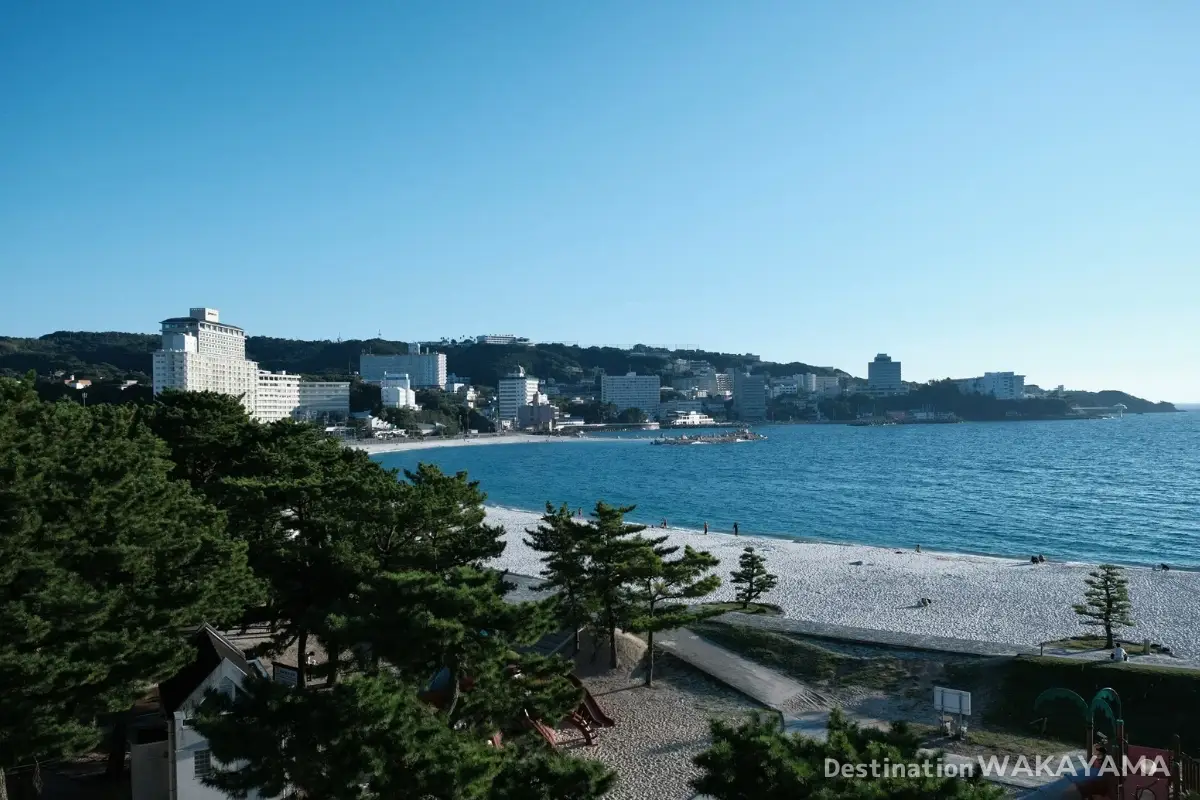
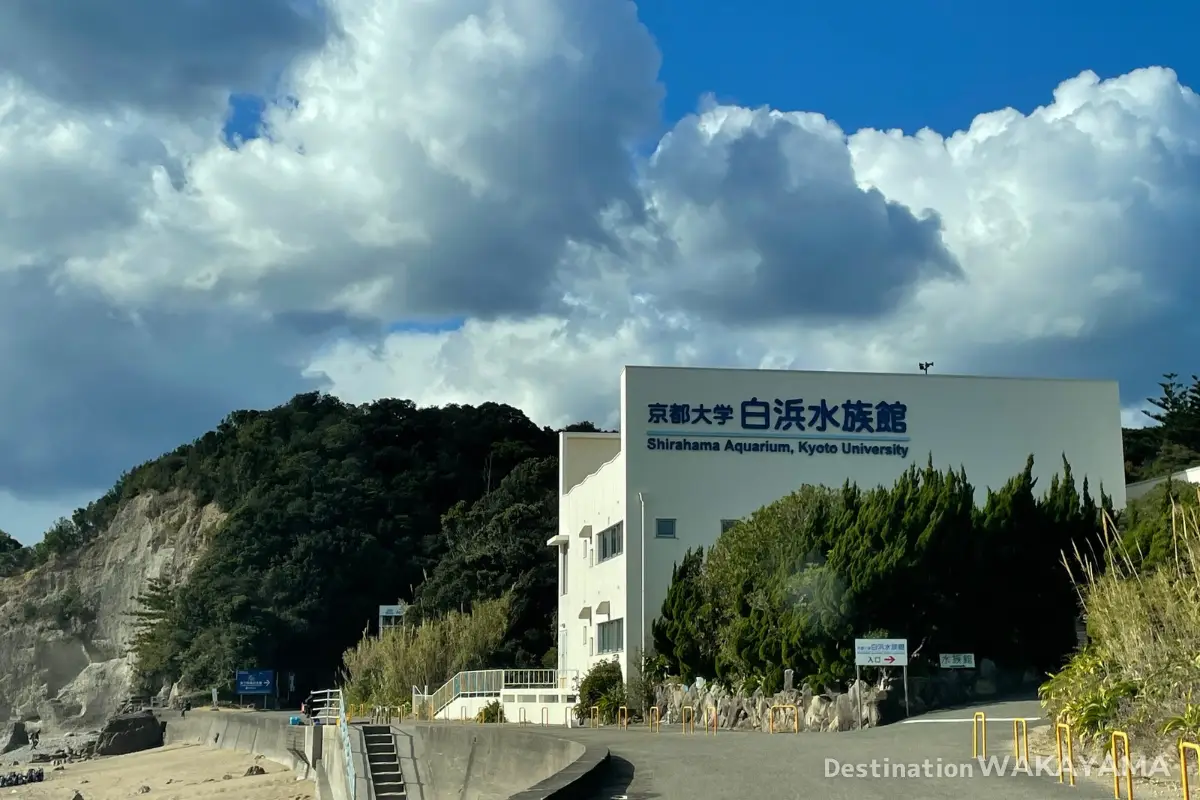

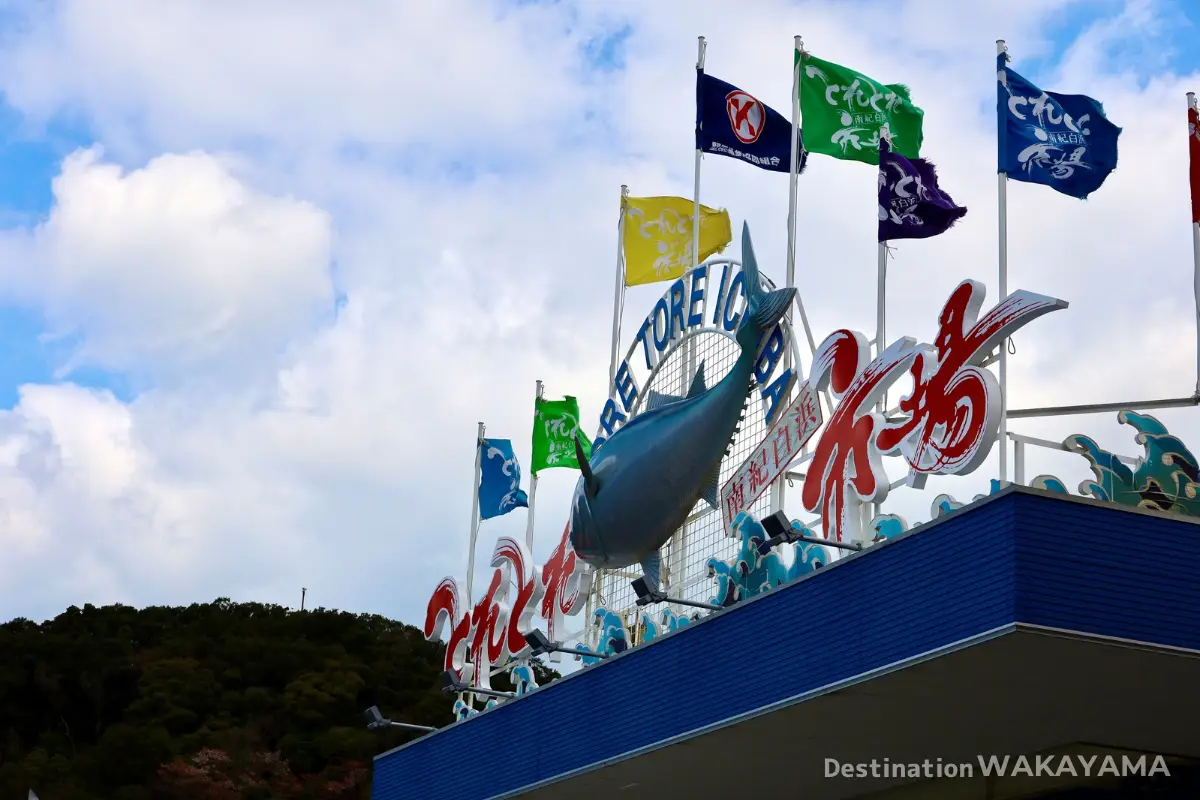

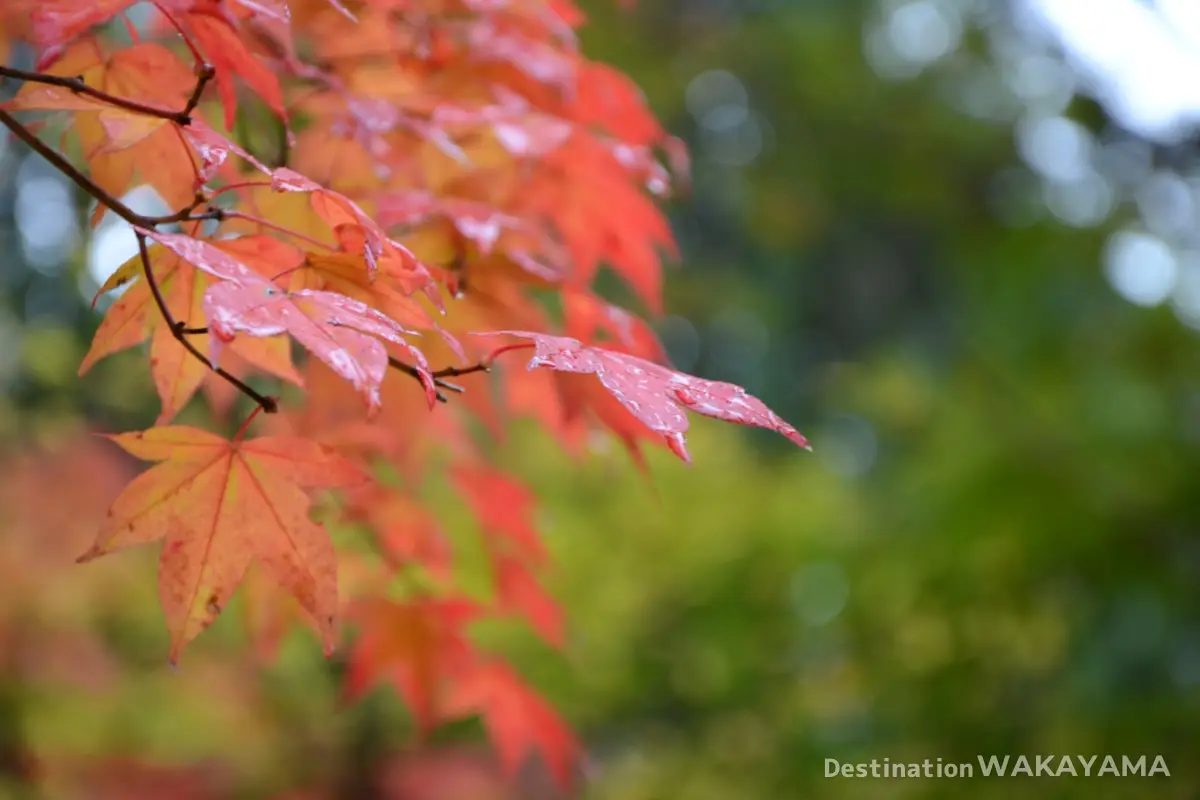
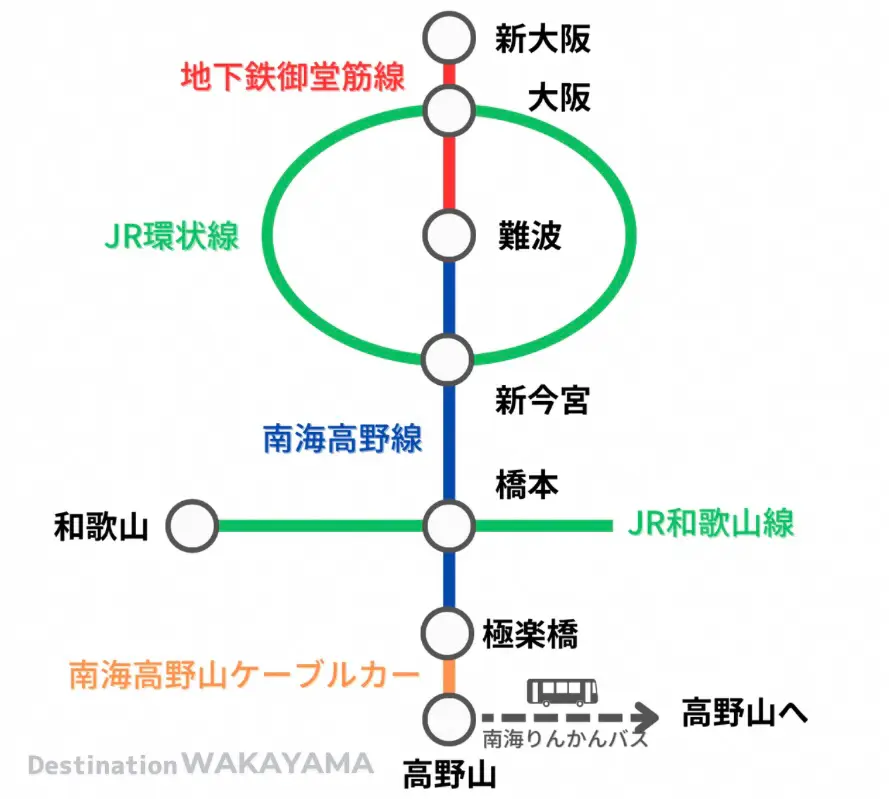
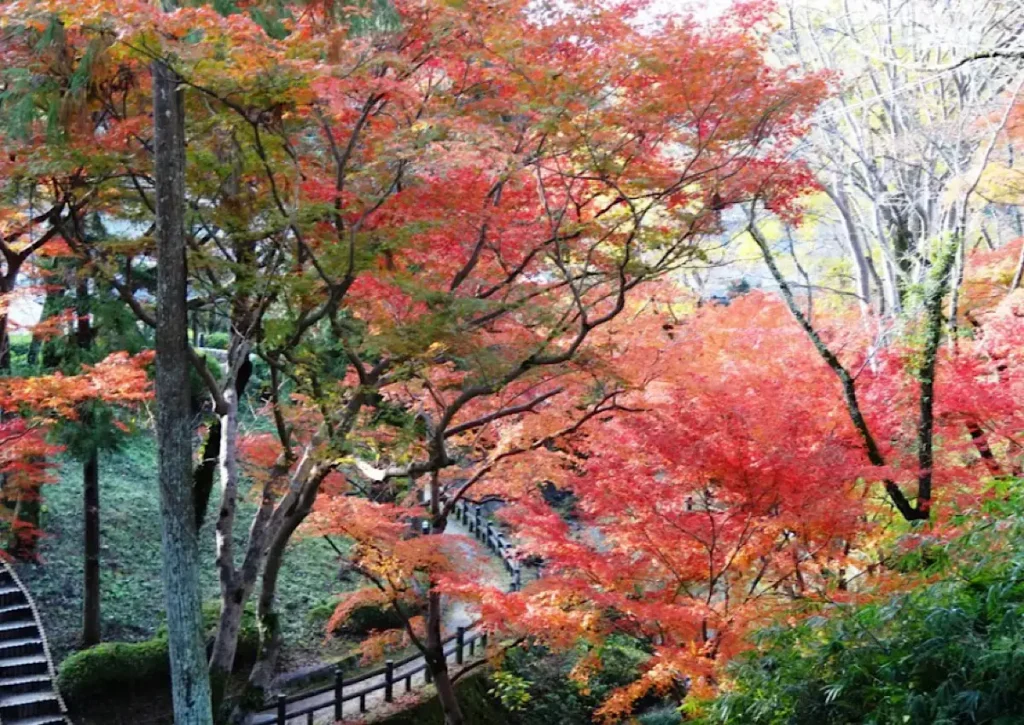
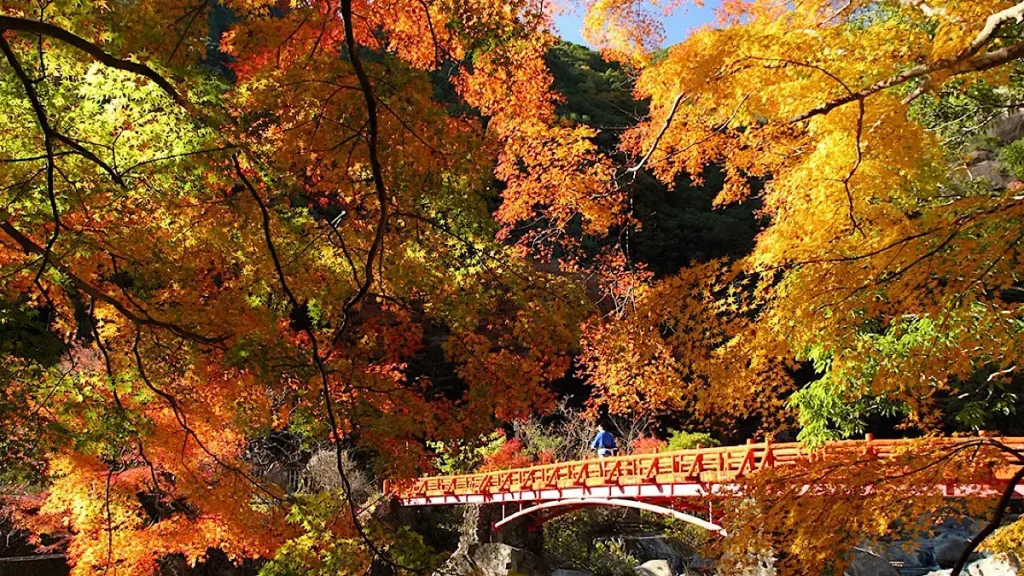
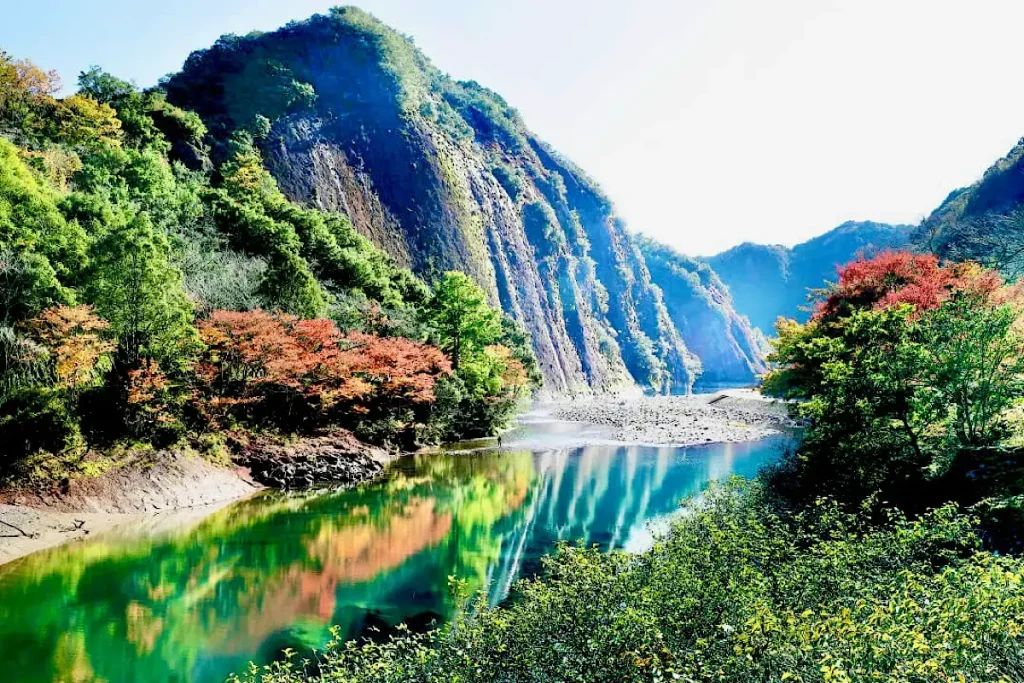

Comments